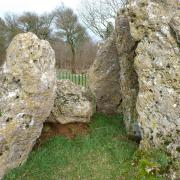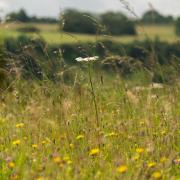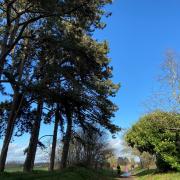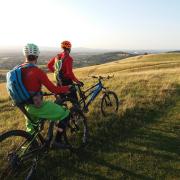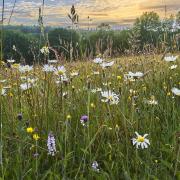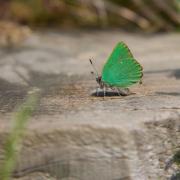Can a new ‘super woodland’ help to tackle the impacts of climate change?

Three neighbouring Wildlife Trusts, Gloucestershire, Worcestershire and Herefordshire, have joined forces to launch a project that will connect two of England’s largest native woodlands.
The Severn Treescapes: Wye to Wyre project will create a wooded landscape at a scale never before seen in the region – a 60-mile corridor stretching from the Lower Wye Valley and Forest of Dean in the south to the Wyre Forest in the north, connecting both people and nature.
While we might think of the Lower Wye to Wyre landscape being well wooded, after all it does contain two of the country’s larger forests, the wider landscape has seen a continued reduction in tree coverage, exacerbated by ash dieback disease and extreme weather events.

Steve Bloomfield, senior conservation officer at Worcestershire Wildlife Trust, says, ‘local Wildlife Trusts work really hard for wildlife in their own counties, but often in isolation. Increasingly, we’re realising the need to work at a landscape scale if we’re going to produce bigger and better results, whilst tackling the impacts of the climate and ecological crises. This project not only enables us to pool resources and contacts, but will allow us to work beyond our boundaries to deliver vast improvements for wildlife, and people.’
But what does ‘Treescapes’ actually mean?
You’d be forgiven for thinking that this just involves a lot of tree-planting. However, while tree-planting initiatives do form part of the plans, the project is about so much more than planting trees.
‘Connected tree cover is what we’re after,’ explains Dr Juliet Hynes, Gloucestershire Wildlife Trust’s Head of Ecological Evidence, and the brains behind the project. ‘We’re not talking about wall-to-wall woodland, though; hedgerows and orchards have a really important role to play too and will help us to build on remaining pockets of ancient woodland.’
Hedgerows can be a big help in tackling the impacts of climate change – they not only provide shade in the summer, but fruit and nuts for birds and small mammals in the winter, as well as increased water infiltration. Like trees, hedgerows can also help to reduce flooding by slowing how fast water reaches the ground and then helping it soak into the soil.
An increase in hedgerows and trees will also create leafy corridors for wildlife, enabling species to move across the landscape better and establish new populations. This is essential in ensuring that certain species aren’t isolated to one area, reducing the risk of local extinctions. A single oak tree can support as many as over 2,000 different species, and wildlife from adders to butterflies all depend on habitats that include trees.
Farming for wildlife
Food security now and for the future is a serious issue, which is why the project isn’t looking to take quality agricultural land out of production. Farmland accounts for about 75% of how the land is used in the project area, so one of the main aims is to support farmers as they explore innovative ways of increasing tree cover within the landscape while maintaining productivity.
This might include bushier hedgerows, trees in fields, restoring traditional orchards or developing wood pastures. The project team will also be working with landowners to find suitable locations for woodland creation as well as considering the evidence and application of more innovative solutions like agroforestry (interspersing lines of trees through crops), which has been used successfully in Europe and is now being trialled in Britain.
‘Trees and hedgerows have many benefits in the farmed landscape and, with the impacts of climate change that we are already seeing, farmers may be recognising a need for more livestock shelter and shading,’ adds Juliet. ‘Heat stress has been shown to reduce productivity in dairy and beef cattle, and bigger bushier hedgerows with the right trees planted in the right place can provide shade and reduce their stress.’

Trees can also provide an additional source of browsing for livestock, as well as aiding in water and soil retention, and alleviating the risk of flooding.
Along with supporting farmers and landowners with grants advice and applications assistance, the team will be organising demonstration site visits and farmer events to shine a light on the opportunities and markets that more trees could provide. From timber production, carbon trading, livestock shelter and food production like fruit and nuts, to soil condition enhancement and pest and disease resilience.
Community connections
Many of us will have found solace and peace in a woodland walk, especially in recent years. The emergence of the Japanese phrase “forest bathing” as a more well-known term, used to describe a woodland visit to relax and de-stress in nature, illustrates just how important the calming power of trees have in an increasingly busy and digital world.
From the fascination of gnarled ancient trees to the joy of planting your own tree seed and watching it grow with you over your lifetime, trees have a special place in our hearts. What’s more, the wellbeing benefits of being in nature and around trees are well known and vital to our health and happiness. Spending time with trees can stabilise blood pressure and alleviate stress and anxiety, as well as increase anti-cancer cells and promote recovery from surgery. That’s why an important aspect of the project is working with local communities, encouraging people to forge deeper connections with trees and better understand their value through guided walks, as well as native tree seed collecting and growing events.


‘It’s estimated that visits to the UK’s woodlands saves £185 million in treatment costs each year,’ explains Claire Spicer, head of conservation at Herefordshire Wildlife Trust. ‘Through the Severn Treescapes project, we have a real opportunity to bring a lot of people closer to nature and trees - with 12% of England’s population within just a 30-minute drive of the project area. That’s an exciting prospect!’
Faced with the challenge of engaging with 5,000 people – one of the project’s measurable targets – the team have joined forces with Ourboretum, an initiative launched by BBC Radio Gloucestershire producer Chris Sandys.
‘Since we launched Ourboretum in 2020, I have been hugely encouraged by the vast number of people who were excited to join in by collecting nuts and growing trees from seed,’ says Chris. ‘We’ve had workplaces growing in teams, schools joining in with education, couples marking special anniversaries and families remembering lost loved ones – all helping grow our trees of the future. Now the mission continues to find the land we need to plant them all and plug the many home-grown stories into the earth.’

A team of on the ground project advisors will be delivering a programme of community events and guided walks and talks, as well as working with Ourboretum to run a series of native tree seed collecting and growing events - encouraging local people to gather seeds and grow saplings at home, before planting them back into the project area.
This work will connect communities and wild places and rebuild connections to our hedgerows, trees orchards and more, sowing the seeds of improvements for future generations to enjoy.




